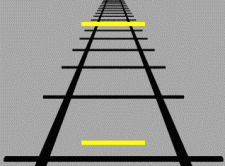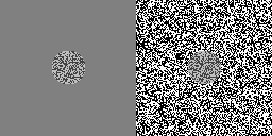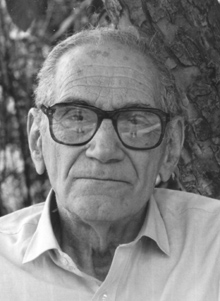
Perception is the organization, identification, and interpretation of sensory information in order to represent and understand the presented information or environment.
An illusion is a distortion of the senses, which can reveal how the human brain normally organizes and interprets sensory stimulation. Although illusions distort our perception of reality, they are generally shared by most people.

Within visual perception, an optical illusion is an illusion caused by the visual system and characterized by a visual percept that arguably appears to differ from reality. Illusions come in a wide variety; their categorization is difficult because the underlying cause is often not clear but a classification proposed by Richard Gregory is useful as an orientation. According to that, there are three main classes: physical, physiological, and cognitive illusions, and in each class there are four kinds: Ambiguities, distortions, paradoxes, and fictions. A classical example for a physical distortion would be the apparent bending of a stick half immerged in water; an example for a physiological paradox is the motion aftereffect. An example for a physiological fiction is an afterimage. Three typical cognitive distortions are the Ponzo, Poggendorff, and Müller-Lyer illusion. Physical illusions are caused by the physical environment, e.g. by the optical properties of water. Physiological illusions arise in the eye or the visual pathway, e.g. from the effects of excessive stimulation of a specific receptor type. Cognitive visual illusions are the result of unconscious inferences and are perhaps those most widely known.
A tactile illusion is an illusion that affects the sense of touch. Some tactile illusions require active touch, whereas others can be evoked passively. In recent years, a growing interest among perceptual researchers has led to the discovery of new tactile illusions and to the celebration of tactile illusions in the popular science press. Some tactile illusions are analogous to visual and auditory illusions, suggesting that these sensory systems may process information in similar ways; other tactile illusions don't have obvious visual or auditory analogs.

Color constancy is an example of subjective constancy and a feature of the human color perception system which ensures that the perceived color of objects remains relatively constant under varying illumination conditions. A green apple for instance looks green to us at midday, when the main illumination is white sunlight, and also at sunset, when the main illumination is red. This helps us identify objects.

The term phi phenomenon is used in a narrow sense for an apparent motion that is observed if two nearby optical stimuli are presented in alternation with a relatively high frequency. In contrast to beta movement, seen at lower frequencies, the stimuli themselves do not appear to move. Instead, a diffuse, amorphous shadowlike something seems to jump in front of the stimuli and occlude them temporarily. This shadow seems to have nearly the color of the background. Max Wertheimer first described this form of apparent movement in his habilitation thesis, published 1912, marking the birth of Gestalt psychology.

Figure–ground organization is a type of perceptual grouping that is a vital necessity for recognizing objects through vision. In Gestalt psychology it is known as identifying a figure from the background. For example, black words on a printed paper are seen as the "figure", and the white sheet as the "background".
Multisensory integration, also known as multimodal integration, is the study of how information from the different sensory modalities may be integrated by the nervous system. A coherent representation of objects combining modalities enables animals to have meaningful perceptual experiences. Indeed, multisensory integration is central to adaptive behavior because it allows animals to perceive a world of coherent perceptual entities. Multisensory integration also deals with how different sensory modalities interact with one another and alter each other's processing.
Sensory substitution is a change of the characteristics of one sensory modality into stimuli of another sensory modality.

The Ponzo illusion is a geometrical-optical illusion that was first demonstrated by the Italian psychologist Mario Ponzo (1882–1960) in 1911. He suggested that the human mind judges an object's size based on its background. He showed this by drawing two identical lines across a pair of converging lines, similar to railway tracks. The upper line looks longer because we interpret the converging sides according to linear perspective as parallel lines receding into the distance. In this context, we interpret the upper line as though it were farther away, so we see it as longer – a farther object would have to be longer than a nearer one for both to produce retinal images of the same size.
The kappa effect or perceptual time dilation is a temporal perceptual illusion that can arise when observers judge the elapsed time between sensory stimuli applied sequentially at different locations. In perceiving a sequence of consecutive stimuli, subjects tend to overestimate the elapsed time between two successive stimuli when the distance between the stimuli is sufficiently large, and to underestimate the elapsed time when the distance is sufficiently small.
The size–weight illusion, also known as the Charpentier illusion, is named after the French physician Augustin Charpentier because he was the first to demonstrate the illusion experimentally. It is also called De Moor's illusion, named after Belgian physician Jean Demoor (1867-1941).
Emmert's law states that objects that generate retinal images of the same size will look different in physical size if they appear to be located at different distances. Specifically, the perceived linear size of an object increases as its perceived distance from the observer increases. This makes intuitive sense: an object of constant size will project progressively smaller retinal images as its distance from the observer increases. Similarly, if the retinal images of two different objects at different distances are the same, the physical size of the object that is farther away must be larger than the one that is closer.
A sensory cue is a statistic or signal that can be extracted from the sensory input by a perceiver, that indicates the state of some property of the world that the perceiver is interested in perceiving.

The Chubb illusion is an optical illusion or error in visual perception in which the apparent contrast of an object varies substantially to most viewers depending on its relative contrast to the field on which it is displayed. These visual illusions are of particular interest to researchers because they may provide valuable insights in regard to the workings of human visual systems.
A perceptual paradox illustrates the failure of a theoretical prediction. Theories of perception are supposed to help a researcher predict what will be perceived when senses are stimulated.
The cutaneous rabbit illusion is a tactile illusion evoked by tapping two or more separate regions of the skin in rapid succession. The illusion is most readily evoked on regions of the body surface that have relatively poor spatial acuity, such as the forearm. A rapid sequence of taps delivered first near the wrist and then near the elbow creates the sensation of sequential taps hopping up the arm from the wrist towards the elbow, although no physical stimulus was applied between the two actual stimulus locations. Similarly, stimuli delivered first near the elbow then near the wrist evoke the illusory perception of taps hopping from elbow towards wrist. The illusion was discovered by Frank Geldard and Carl Sherrick of Princeton University, in the early 1970s, and further characterized by Geldard (1982) and in many subsequent studies. Geldard and Sherrick likened the perception to that of a rabbit hopping along the skin, giving the phenomenon its name. While the rabbit illusion has been most extensively studied in the tactile domain, analogous sensory saltation illusions have been observed in audition and vision. The word "saltation" refers to the leaping or jumping nature of the percept.
In human visual perception, the visual angle, denoted θ, subtended by a viewed object sometimes looks larger or smaller than its actual value. One approach to this phenomenon posits a subjective correlate to the visual angle: the perceived visual angle or perceived angular size. An optical illusion where the physical and subjective angles differ is then called a visual angle illusion or angular size illusion.
A sense is a biological system used by an organism for sensation, the process of gathering information about the world and responding to stimuli. Although traditionally around five human senses were known, it is now recognized that there are many more. Senses used by other non-human organisms are even greater in variety and number. During sensation, sense organs collect various stimuli for transduction, meaning transformation into a form that can be understood by the brain. Sensation and perception are fundamental to nearly every aspect of an organism's cognition, behavior and thought.

Hans Wallach was a German-American experimental psychologist whose research focused on perception and learning. Although he was trained in the Gestalt psychology tradition, much of his later work explored the adaptability of perceptual systems based on the perceiver's experience, whereas most Gestalt theorists emphasized inherent qualities of stimuli and downplayed the role of experience. Wallach's studies of achromatic surface color laid the groundwork for subsequent theories of lightness constancy, and his work on sound localization elucidated the perceptual processing that underlies stereophonic sound. He was a member of the National Academy of Sciences, a Guggenheim Fellow, and recipient of the Howard Crosby Warren Medal of the Society of Experimental Psychologists.










